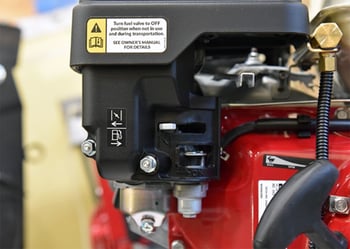Why The Fuel Valve Is Important On Small Gas Engines
 Imagine you just finished a job using your gas drive air compressor, and you’re getting ready to drive to your next job. Did you remember to shut off your fuel valve? In this article, we’ll explain why you should.
Imagine you just finished a job using your gas drive air compressor, and you’re getting ready to drive to your next job. Did you remember to shut off your fuel valve? In this article, we’ll explain why you should.
Turn Off The Fuel Valve To Protect Your Engine
Most small gas engines have a fuel valve that should be shut off when the engine is not in use. The Honda engines used in VMAC G30 Gas Powered Air Compressors and Kohler engines used in other air compressor brands state in their literature that fuel valves need to be shut off when not in use, especially during transport.
Fuel shut-off is important when moving equipment because vibration can cause the carburetor needle valve to move, which allows fuel to trickle into the carburetor, the float chamber and down the intake valve. This fuel trickle can result in the following:
- Engine flood, causing downtime waiting for the flood to clear.
- Dilution when fuel goes past piston rings and mixes with oil, causing engine damage.
- Hydraulic lock, in which incompressible liquid causes engine damage or failure.
All three of these issues can damage or destroy an air compressor. Fortunately, they are easily preventable if you use the fuel valve.
Engine Flood
Any time vibration causes the carburetor float to drop in the float chamber, pressure is reduced against the needle valve. Reduced pressure against the needle valve allows pressurized fuel from the fuel tank to pass through the valve.
If this happens frequently, fuel will overfill the float chamber, flood down the throat of the carburetor, and flow into the cylinder through the open intake valve.
Oil Dilution
Fuel within the cylinder will also slowly drain past the piston rings, diluting the oil in the crankcase. This degrades the quality of the oil and poses a significant risk to the system. If the engine manages to start with diluted oil, severe and premature engine damage will follow.
Hydraulic Lock
Fuel in the cylinder can flood the combustion chamber above the piston, creating hydraulic lock, which is also known as hydrolock. Liquids are essentially incompressible, so this leaked fuel prevents the engine from turning.
How Does The Fuel Float Work?
The float chamber is located below the carburetor body, and fuel flows through the needle valve into the fuel tank's float chamber. The float chamber maintains a constant fuel level while the engine works using a float and the needle valve.
When the fuel rises to a specific level, the float rises. When the float's buoyancy balances with the fuel pressure, the needle valve shuts off the fuel passage, thereby maintaining the fuel at the predetermined level.
Shutting off the fuel valve prevents the engine from flooding while being transported, but it also prevents flooding due to contamination in the float valve and extends the life of the float valve by decreasing pressure on it.
